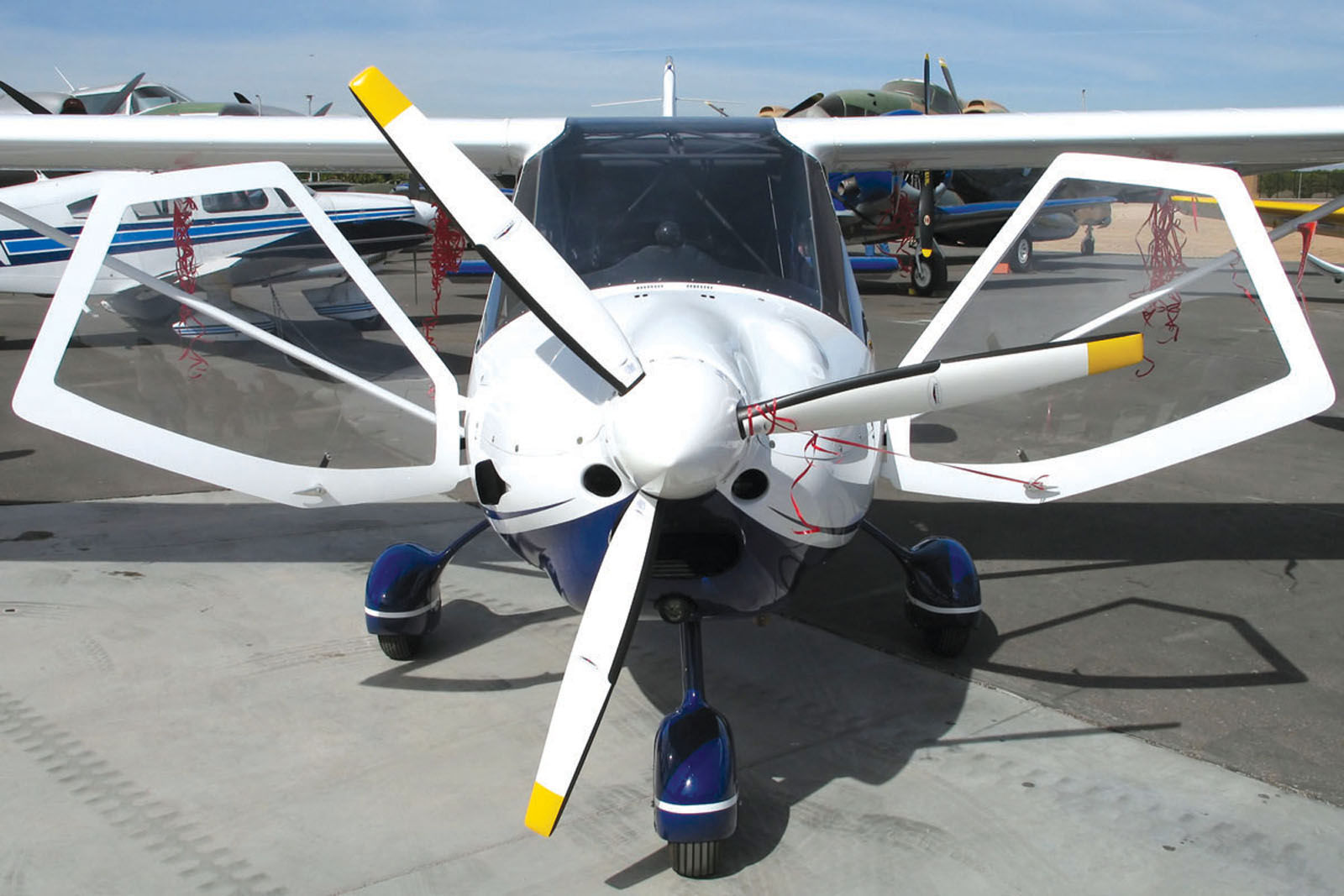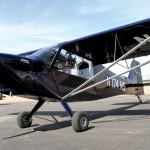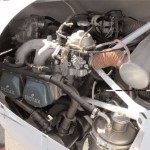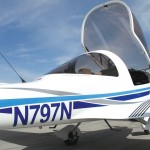By Dan Sobczak,
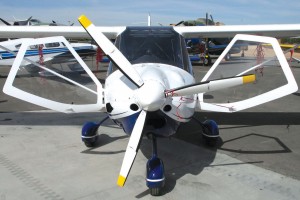
The MD-3 Sport Rider’s side canopy doors open toward the nose of the aircraft, making entering and exiting the cockpit a breeze.
On February 18, the Experimental Aircraft Association’s Sport Pilot Tour made a stop at Falcon Field in Mesa, Ariz., the tour’s sixth and most successful event to date. It drew more than 600 people, and pilots and aviation enthusiasts alike were able to get up close and personal with 18 certified light-sport airplanes, sit in cockpits, talk with aircraft representatives and take demo flights.
Volunteers from EAA chapters 228, 538 and 1217 helped run the event, along with volunteers from the Commemorative Air Force, which provided the tour with the use of its facilities. Many old warbirds in the CAF collection, from World War II era bombers to Vietnam jet fighters, were also on display and provided an exciting backdrop for those who just wanted to come and appreciate aircraft up close.
Forum speakers Ron Wagner and Dan Johnson, EAA Sport Pilot Team representatives, taught attendees about the new sport pilot rules and gave helpful tips regarding important questions to ask when buying a light-sport aircraft.
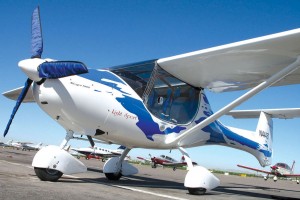
With its three-blade Woodcomp carbon-fiber composite propeller pulling a Kevlar composite fuselage, the Allegro 2000 boasts a 1,000 fpm climb rate at maximum takeoff weight.
“The Phoenix area worked great for us with the tour being at the CAF facility, plus the great flying weather,” Wagner said. “It was a beautiful day, a perfect combination.”
Toward the close of 2004, the Federal Aviation Administration created the new sport-pilot/light-sport aircraft regulations. The new rule makes it easier for aspiring pilots to earn their wings by lowered cost of aircraft and reduced training time required to earn a sport pilot certificate, as compared to the private pilot certificate.
With a minimum of 20 hours of flight training in a sport-certified airplane, and, in most cases, by holding a valid state driver license as proof of medical eligibility, prospective pilots can more easily achieve their dream of flying. A sport pilot must be at least 17 years old and pass an FAA sport pilot knowledge test, as well as an FAA sport pilot practical flight test. The FAA will also credit sport pilot flight time toward advanced pilot ratings, making the next step of becoming a private pilot easier.
For years, EAA worked closely with the FAA in shaping the new sport rule and certifying the new fleet of light-sport aircraft for use in the United States. The event at Falcon Field was the final stop in the first phase of the Sport Pilot Tour, and more dates and locations are being planned.
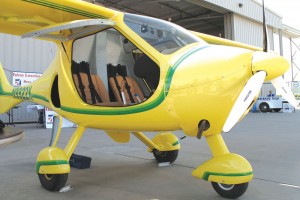
Due to the strength-to-weight ratio of its carbon-fiber and Kevlar structure, the Flight Design CTSW has a range of 1,000 miles and a useful load of 662 lbs—four pounds more than its empty weight.
“We plan to schedule seven to 10 new tour stops in the next year,” Wagner said. “We’re in the process now of determining the future locations.”
Wagner said the crowd seemed to be split evenly among the two types of light-sport enthusiasts: want-to-be pilots and experienced pilots who quit flying, but have a desire to get back into aviation. As a result of the new rule, a new fleet of sport aircraft emerged in 2005. Many of them have been flown for years in Europe, but pilots in this country haven’t had a chance to experience the new fleet until now.
Airplanes certified under the sport rule meet the following performance requirements: single engine with a fixed-pitch propeller and fixed landing gear, a maximum takeoff weight of 1,320 pounds, a never-exceed airspeed of 120 knots, a maximum stall speed of 45 knots, and no more than two seats in an unpressurized cabin.
While every light-sport aircraft meets these strict requirements, that doesn’t necessarily mean each airplane looks and operates the same. EAA exhibitors highlighted their aircraft’s own unique features.
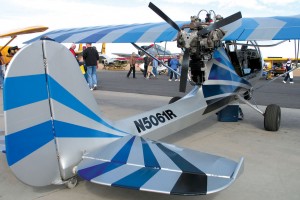
Certified as an experimental light-sport aircraft, the Super Hornet uses an air spring suspension system on all three wheels, designed to protect the aircraft from damage during a hard landing.
The Legend Cub, manufactured by American Legend Aircraft Company, is a throwback to the classic Piper J-3 Cub, which was built and sold throughout the 1930s and 1940s. For those pilots who prefer lakes and waterways as their runways, this new Cub can also be equipped with factory optional floats.
Representatives from Higher Class Aviation showed off the unique suspension system of their Super Hornet, an experimental two-seat, tandem light aircraft. The Hornet uses Goodyear air springs inflated with air, just like a tire. Higher Class Aviation says the air springs will absorb more energy during a hard landing, compared to other bungee-type or carbon-fiber spring landing gear designs, thus reducing the aircraft’s desire to bounce back into the air.
All but one of the light-sport aircraft are manufactured in countries like the Czech Republic, Italy, and other countries throughout Europe. The Zodiac CH 601 XL is currently the only light-sport built in the United States, manufactured by Zenith Aircraft Company of Missouri. The Zodiac XL’s large bubble canopy offers 360 degree visibility, while its 44″ wide cockpit is comfortable and roomy for pilot and passenger.
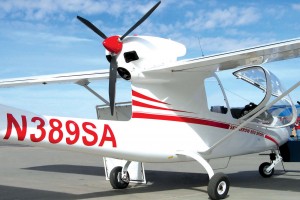
The wrap-around canopy of the Sky Arrow 600 Sport gives pilot and passenger excellent visibility, while the rear propeller pushes the aircraft through the sky at a cruise speed of 95 knots.
The Quad City Ultralight Aircraft Corporation displayed a pair of their Challenger 2 ultralights. A two-seat trainer, the Challenger 2 has a 20 mph crosswind capability, boasts a solo pilot climb rate of 1,200 fpm (700 fpm dual), and operates well on floats.
Many light-sports utilize a composite body, but the Kappa KP-5 is made of an all-aluminum construction in a stylish, yet classic low-wing design. Its high performance wing has Fowler flaps that can be deflected 10 degrees or 35 degrees.
Although few aircraft were sold during the event, Wagner said that all the exhibitors considered the tour successful.
“One manufacturer reported he felt he made at least three sales that day, with two or three more potential buyers who said they would follow up after the show, all as a result of the tour stop at Falcon,” Wagner added.
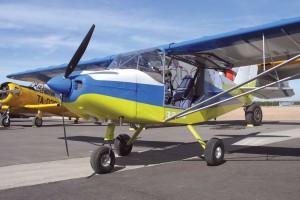
The S-6ES Coyote 2 is RANS’ most popular two-place home-build kit. Depending on wing and power plant configuration, the Coyote’s takeoff roll is no more than 235 feet, with a maximum landing roll of 260 feet.
For complete details of the Sport Pilot/Light-Sport Aircraft Rule and medical requirements, visit www.sportpilot.org. Future EAA Sport Pilot Tour dates will also be listed on that website.
Dan Sobczak, a freelance writer and photographer, has been a private pilot since 2003. In the fall of 2005, he was one of the first pilots in Arizona to get checked out in the Fantasy Air Allegro 2000 light-sport aircraft.
- The RANS S-7LS Courier sports a service ceiling of 14,500 feet. A fully equipped, ready-to-fly Courier comes with such amenities as a Garmin moving map GPS/COM and Transponder.
- Many light-sport aircraft use the Rotax four-stroke engine, such as this 912S 100-hp model in the Kappa KP-5 light-sport airplane.
- The large canopy of the Sting Sport provides a 360 degree view, while the avionics package includes a standard Garmin GPSMAP 396 with docking station.











